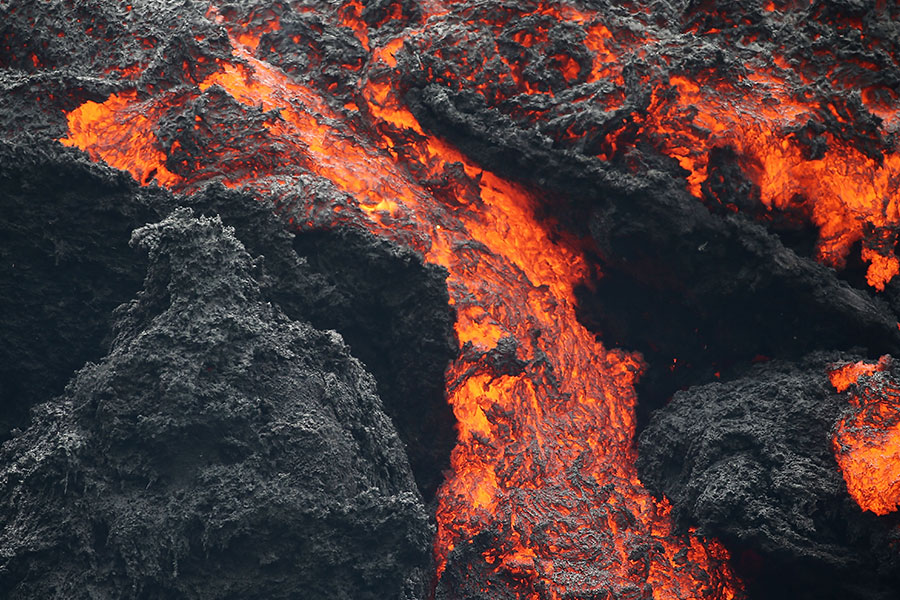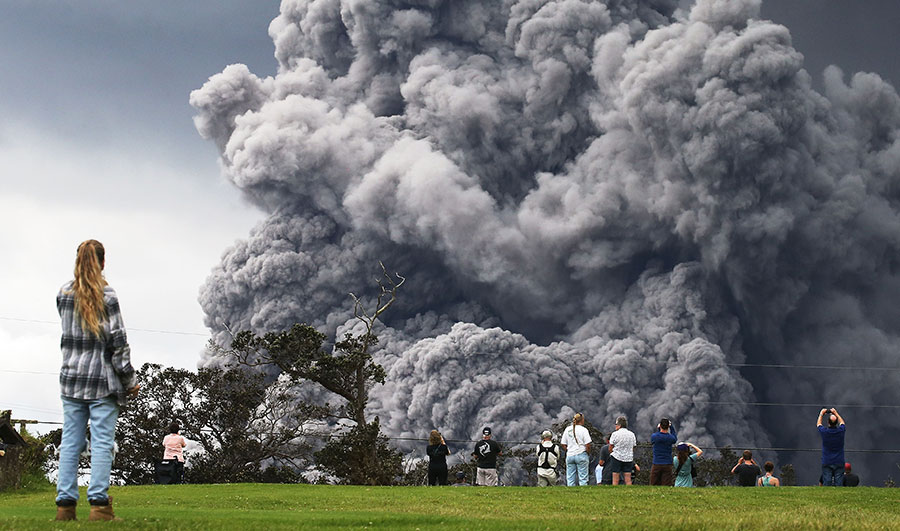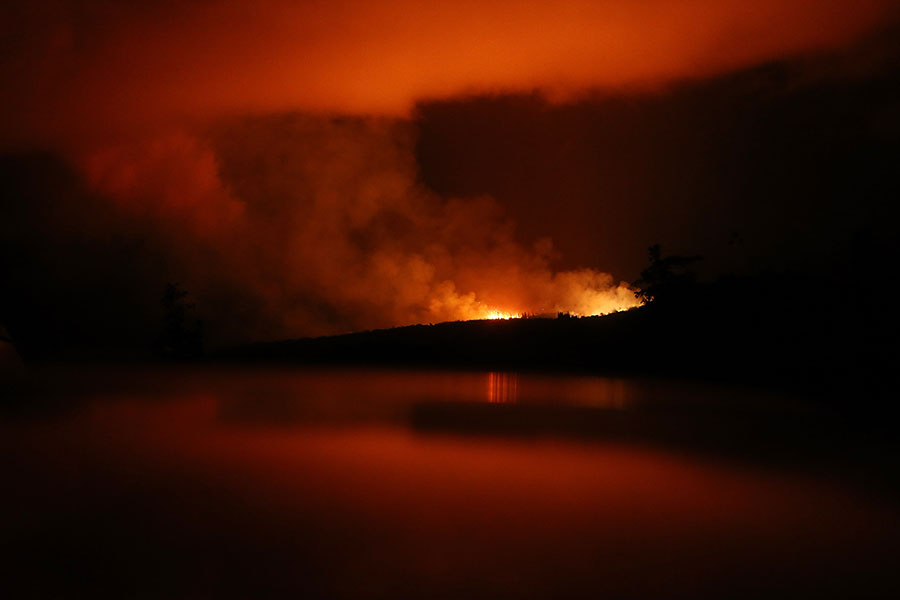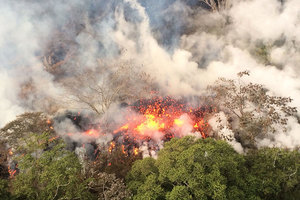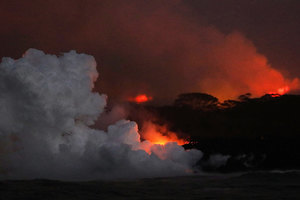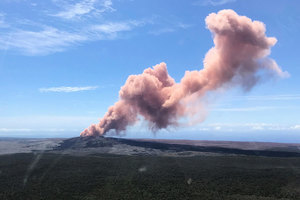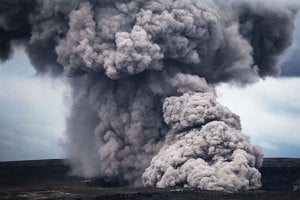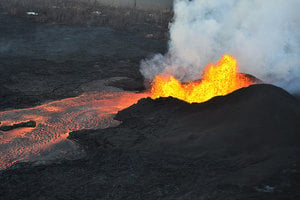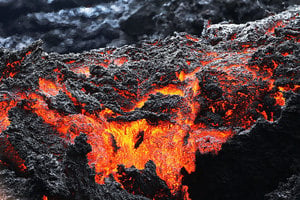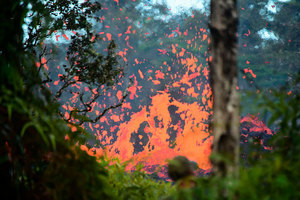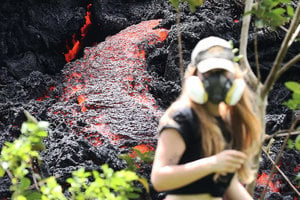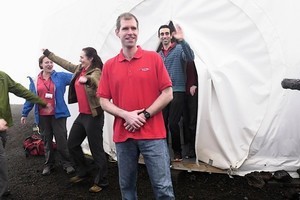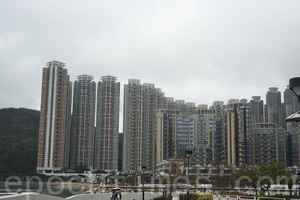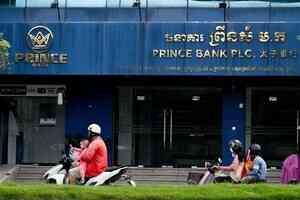夏威夷火山噴發已經持續20多天了,滾燙岩漿繼續流向地勢較低的東斷裂帶(East Rift Zone),科學家捕捉到一幕宛如世界末日的景象:從地表裂縫冒出藍色火焰,且正在引發新的爆炸。
當地緊急部門官員表示,如果帕霍亞(Pahoa)以西的裂縫張開,熔岩可能會堵住高速公路。CBS新聞報道說,如果發生這種情況,大約有1000人將不得不搭乘直昇機轉移到安全地帶。
此外,美國地質調查局(USGS)提供照片顯示,在燃燒的植物與迸出的岩漿之間,可以看到地表裂縫中泛起藍色火焰,場景有如人間煉獄。
Buried and burning vegetation produces methane, ignited in road cracks to produce a blue flame [Kīlauea Volcano’s Lower East Rift Zone]. https://t.co/qm9m5nRLb1 pic.twitter.com/20ceuLcFme
— USGS Volcanoes(@USGSVolcanoes) May 23, 2018
藍色火焰在夏威夷大島上引發令人擔憂的問題:該現象表明甲烷氣體存在。甲烷氣體是熔岩燃燒植物和樹木而產生的。科學家說,如果在地下的樹木被點燃,可能會引發爆炸。
May 23 evening #HVO #Kilauea update #Kilauea: Lava & ground cracking continue in East Rift Zone. New ocean entry N of MacKenzie State Park, 2 total. Frequent small ash emissions at summit. Small summit earthquakes continue (largest M3.5). https://t.co/7sDZqcOJ5s #KilaueaErupts pic.twitter.com/ii7eWB2ohP
— USGS Volcanoes(@USGSVolcanoes) May 24, 2018
地質學家警告,甲烷爆炸時可能會使巨大石塊飛向空中。美國地質調查所正持續提供最新火山噴發狀況,但目前噴發沒有減緩趨勢。
地球物理學家考阿考卡(Jim Kauahikaua)說:「這(可能)是第一次,也許是我第二次看到藍色火焰,這是非常戲劇性的,非常可怕。」
May 24 morning #HVO #Kilauea update: Middle portion of fissure system most active, fissures 2, 7, 8, 3, 14, 21 reactivated & are spattering. High gas emissions near fissures. Small ash emissions and earthquakes at summit continued overnight. https://t.co/7sDZqcx8dU #KilaueaErupts pic.twitter.com/hYDI3RiHzi
— USGS Volcanoes (@USGSVolcanoes) May 24, 2018
夏威夷大島基拉韋厄火山(Kilauea)已經活動達30多年,但在火山頂峰數周前隆起後,這個月進入大規模噴發狀態。過去兩周,夏威夷的火山爆發一直在持續,摧毀汽車、燒毀房屋。成千上萬的居民已經撤離。有些住在紅十字會的三個庇護所中,而另外一些人則與朋友和家人住在一起。
It’s a lot of information, but you’ll want to read all of this evening’s #HVO #Kilauea update (https://t.co/7sDZqcOJ5s) and especially check out this new section of the HVO web site for information on the ongoing activity at Kilauea Volcano: https://t.co/tY5hnsLbCo #KilaueaErupts pic.twitter.com/5gMkISalEd
— USGS Volcanoes (@USGSVolcanoes) May 23, 2018
當地居民亨特(Tam Hunt)說:「(鄰居家的)房子實際上已經落入了裂縫。」並補充說,他的鄰居自1991年以來一直住在那裏並養育了孩子。
亨特說:「這所房子不會再有人住了……永遠,」
UAS flight of Kīlauea Volcano’s Lower East Rift Zone during the overnight hours of May 22, 2018, captures activity at the fissure complex and lava flows that extend to the ocean; helps scientists assess hazards. https://t.co/a5Bv42SxyE pic.twitter.com/hGaZoYZ8YP
— USGS Volcanoes(@USGSVolcanoes) May 24, 2018
基拉韋厄火山爆發後,當局也在夏威夷大島南部海岸線發出有毒氣體的警告,此時熔岩開始流入海洋並引發化學反應。
Spatter and splashing build ramparts around Fissure 22, Kīlauea Volcano’s Lower East Rift Zone. https://t.co/Ol1DixBPI3 pic.twitter.com/rmHvlGOBOh
— USGS Volcanoes(@USGSVolcanoes) May 22, 2018
上周末,熔岩開始湧入大海,因為它與海水相互作用,一直在產生「熔岩霧靄」(Laze)的羽流。夏威夷火山天文台地質學家巴布(Janet Babb)告訴美聯社記者說,這種由稀薄的蒸汽、有毒氣體和火山噴發碎片組成的熾熱氣體「看起來無害,但事實並非如此」。
At Kīlauea Volcano’s summit, a nearly continuous plume of gas and steam billows out of the Overlook vent and drifts with the wind. Overflights collect visual information to quantify change and inform our assessment of hazards. https://t.co/oOL3HwFcrh pic.twitter.com/2rM4WfdKqd
— USGS Volcanoes (@USGSVolcanoes) May 24, 2018
巴布警告說,儘管「熔岩霧靄」本身不足以造成嚴重灼傷,但人們應該保持安全的距離。
基拉韋厄的噴發也產生了地震,湧出熔岩、巨大的火山灰和二氧化硫。
Fissure 22 jets 160+ ft into the air; three short videos show fissure complex in Kīlauea Volcano’s Lower East Rift Zone, May 22, 2018. https://t.co/cF2LtmpkrT pic.twitter.com/ebkFZcPnL9
— USGS Volcanoes(@USGSVolcanoes) May 24, 2018
美國地質調查局地球物理學家波蘭德(Mike Poland)表示,基拉韋厄火山每幾小時發生一次較大的爆炸。
--------------------
向每位救援者致敬
願香港人彼此扶持走過黑暗
--------------------
🔔下載大紀元App 接收即時新聞通知:
🍎iOS:https://bit.ly/epochhkios
🤖Android:https://bit.ly/epochhkand
📰周末版實體報銷售點👇🏻
http://epochtimeshk.org/stores
